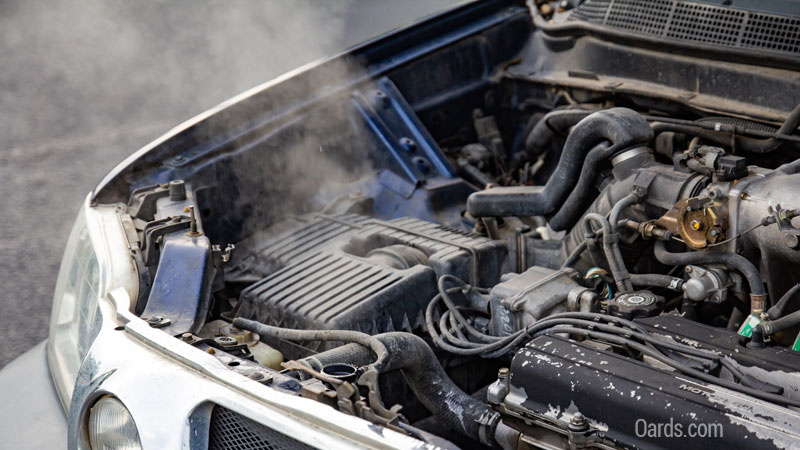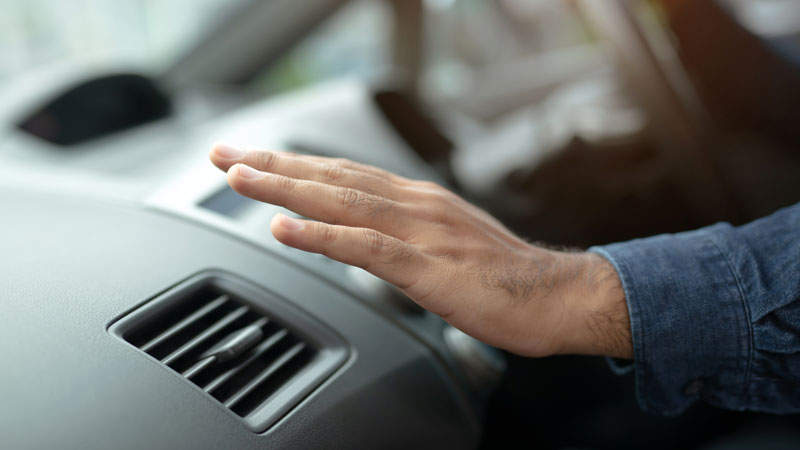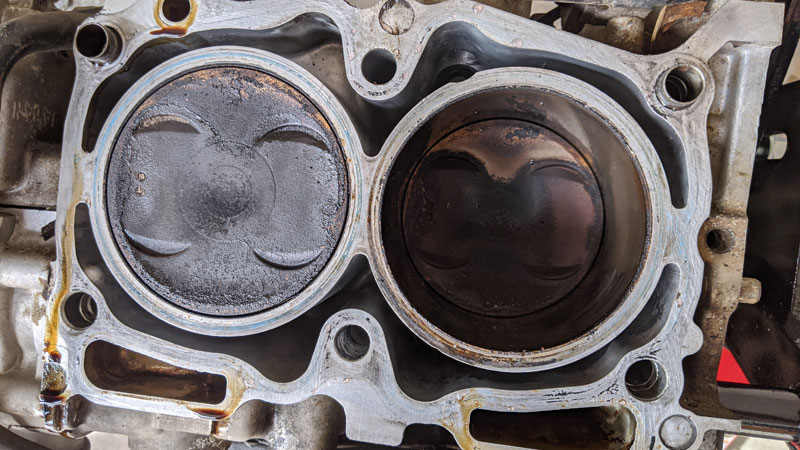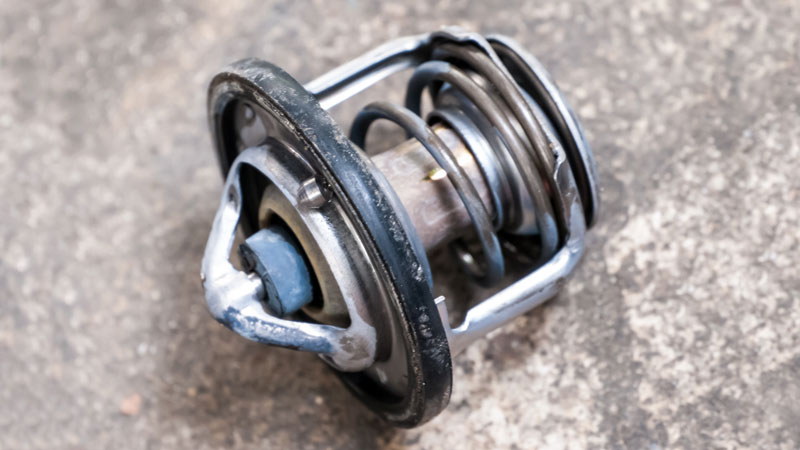When you get too cold or hot in your house, you probably adjust the thermostat to change the temperature in the room. Engine blocks can also get too hot or too cold so a thermostat is necessary to manage engine temperature.
How Does a Thermostat Work?
Unlike the thermostat in your home, most thermostats used in cars do not require electricity. Inside your thermostat, there is a wax element blocking the flow of coolant. This wax is designed to melt at a specific temperature. The expansion of wax from melting pushes a valve open in the thermostat, which allows coolant from the radiator to enter the engine block.
Coolant in the radiator is roughly the same temperature as the ambient air when at rest. The coolant absorbs heat from the engine as it cycles through the radiator.
Once the engine temperature reduces, the cycling coolant temperature is close enough to ambient temperature to cool the wax back down which hardens it and closes the thermostat again. This cycle repeats to keep the engine within a specific temperature range.
Thermostats come in different temperature ranges depending on the engine and application. A 180° thermostat will begin to open when coolant in the engine block is within 3 degrees of 180° Fahrenheit. The thermostat will be fully open when engine coolant is 15-20 degrees above 180° F.
If you’re looking to buy a new thermostat, be sure to choose it according to the OEM’s specifications for your vehicle. Different engines run best at different operating temperatures.
Bad Thermostat Symptoms
1) Overheating

The most obvious symptom that your thermostat has gone bad is your vehicle overheating. If a thermostat is stuck closed then the coolant can’t circulate. This leaves the hot coolant stuck in the radiator, and the engine can’t be cooled by fresh coolant.
See Also: How to Stop Your Car From Overheating
2) Poor Engine Performance

When your engine is cold, it doesn’t run as efficiently as it does at operating temperature. Your engine is built with specific tolerances that are designed for running within a specific temperature range. If the thermostat is stuck open, then the coolant temperature will continue to lower as it cycles through the radiator even if the engine temperature lowers below operating temperature.
Operating temperature is the temperature of optimal engine combustion. As metal in the engine heats, it expands. This fills up some of the empty space between the piston and the cylinder wall, creating a better seal inside the combustion chamber. A better seal means the engine will make more compression which increases efficiency.
If your exhaust has a strong fuel smell, your car may be running rich (more fuel is injected into the combustion chamber than can be burned up) because the engine is cold. A car that runs rich will yield poor fuel economy and excessive carbon buildup over time. Spark plugs may become fouled as well.
Poor fuel economy also increases your vehicle’s emissions, which is more harmful to the environment.
3) Temperature Gauge Stays Cold

If the thermostat is stuck in the open position, your car may never reach operating temperature. This is especially true on a cold winter day, where engine heat dissipates very quickly.
If your temperature gauge is stuck on the cold side or barely moves off of “C”, you may want to check your instrument cluster and coolant temperature sensor as well.
4) Heater Doesn’t Work

Heat inside your vehicle’s cabin is provided by a heater core. The heater core is very similar to the radiator at the front of the car and works on the same principle.
Inside a heater core, coolant flows from one side to the other, heating up the core. As air passes over this warm core, the air is warmed up. This warm air then makes its way into the vehicle’s HVAC system and blows out of the vents.
Depending on how the thermostat fails and where the heater core sits with respect to the thermostat, the heater core may get cold when the thermostat fails. This is because the heater core only has access to ambient temperature coolant and has been cut off from the hot coolant in the block.
If the thermostat fails while open, it may take an unusually long time for the cabin to heat up. You may also notice the heat from the vents fluctuate, going from hot to cold to hot again without touching the HVAC temperature settings.
These symptoms may also occur if there is an air pocket in the heater core.
5) Blown Radiator Hose

As temperature builds in the engine block, pressure builds as well. The cooling system is a pressurized system, but it is only designed to hold so much pressure. If your engine gets too hot, you may start to notice some of the rubber parts start to leak or even burst.
This is very dangerous because the pressurized coolant is extremely hot and could easily spray into your eyes, face, or hands and cause severe burns.
If you experience this symptom, first turn off the vehicle and stay away from it until it cools. Next, check your radiator cap as well to make sure it is the correct pressure for your vehicle. A radiator cap that holds too much pressure will also exhibit these symptoms.
See Also: 3 Causes of Radiator Hose Collapse
Can You Drive Without a Thermostat?
A short term solution to a thermostat that is stuck closed is to remove the thermostat entirely.
While it is possible to drive without a thermostat, it is not wise to do so long term. Engines don’t run as well before they reach operating temperature.
If you are missing your thermostat, your engine will probably not be able to reach operating temperature (unless it’s very hot outside and you are running your car hard as on a race track).
Other Causes With These Symptoms

Cooling system problems can be tricky to diagnose. This is because many parts will exhibit similar symptoms when they fail. If your vehicle is overheating, there are several parts of the cooling system that may be the cause.
You may also want to consider checking or replacing any of the following items, depending on your symptom above:
- Check your coolant level. If it’s low, also check for coolant leaks.
- Burp your radiator. Properly bleeding the radiator of air ensures there are no air pockets that can create hot spots in the engine.
- Check or replace your radiator cap.
- Replace your radiator.
- Replace the heater core.
- Replace the head gasket(s). If you have a Subaru, you can learn more about Subaru head gasket failures here.
- Replace your intake manifold gasket(s).
Since there are many components that make up the cooling system, it’s best not to throw parts at the car (unless they’re cheap parts you haven’t replaced in a long time, such as the radiator cap).
If you’re unsure how to test your cooling system, consult a professional to help you narrow down the problem. A good mechanic with a mature troubleshooting process will be able to help you diagnose and pinpoint the root cause without spending money on unnecessary parts.
Car Thermostat Replacement Cost
We recommend Parts Geek for the best prices and selection.
If you’ve determined that the thermostat is the problem, expect to pay between $40 and $80 for a new thermostat. The cost can vary greatly, however, depending on the quality you are buying and the vehicle the thermostat will reside in – from $7 (for some older vehicles such as some Toyota Corollas) to $1230 (for luxury or sports cars such as some Mercedez-Benz).
Labor cost to replace a thermostat will also depend on the vehicle and how difficult the thermostat is to access. Typically, labor cost is usually between $100 and $300.
Can I Replace a Thermostat Myself?
If you are confident in your mechanical abilities, it would certainly be cost-effective to replace the thermostat in your vehicle yourself. It’s usually easy to access, near the large upper or lower radiator hoses where they join the engine block.
This is a job that can have severe consequences to your health, or your vehicle, if it’s done wrong. The cooling system is designed to run under pressure so there can be no loose connections that will cause a dangerous leak.
Fortunately, if the vehicle is worked on when it’s cool (safety first!), and all connections are secured properly, you can replace the thermostat at home in less than a day.
How Long Do Car Thermostats Last?
Auto technicians recommend replacing thermostats every 10 years, but thermostats may last longer or shorter depending on their quality and run conditions.
- Power Windows Not Working? (10 Common Causes and How to Fix) - February 8, 2024
- 14 Causes of a Car Losing Power When Accelerating - January 23, 2024
- 13 Causes of Poor Gas Mileage (Increase Your MPG) - December 13, 2023


Hello I’m changing water pump on 2008 dodge charger I sprayed on blaster in spark plug holes I already took off timing chain how do I empty cylinders before putting spark plugs can I turn the engine over I have it lined up on crankshaft is lined up can I turn over engine to drain cylinders
What did you spray in the holes? You could just put a thin hose down there with a fluid pump and pull it out that way.